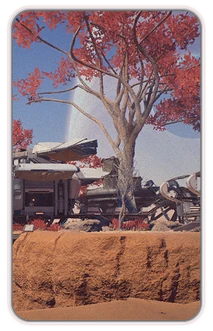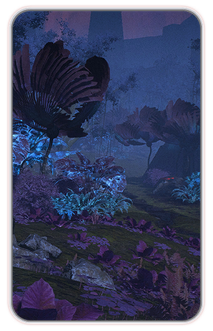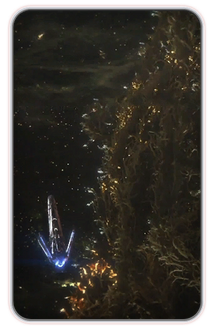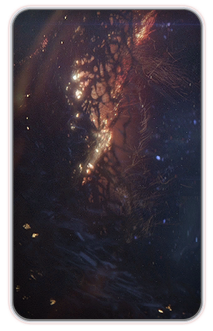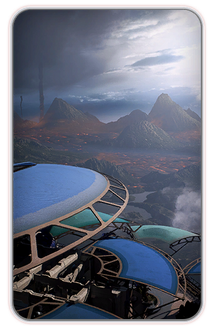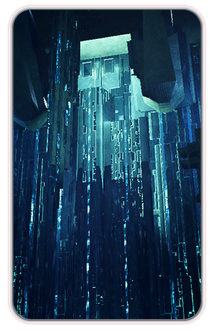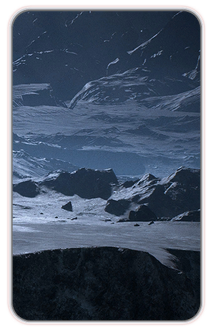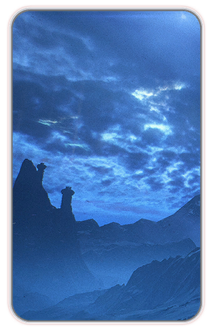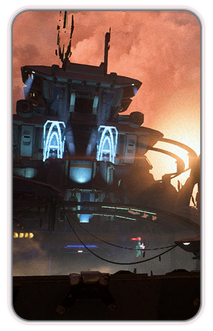The Heleus Cluster contains many habitable worlds and other points of interest for the Pathfinder to explore.
Habitat 7[]
The planet known as Habitat 7 was one of the "golden worlds" selected by the Andromeda Initiative for early settlement. Signs pointed to a lush and biologically diverse tropical region that could easily support an outpost.
With no communications from the Nexus or sister arks upon arrival in the Heleus Cluster, the Hyperion approached Habitat 7 to begin survey and settlement operations as soon as possible, but even visual assessments showed that the planet was no longer viable. Habitat 7 is now a storm-wracked world with an unbreathable argon-nitrogen atmosphere. Intense magnetic activity in unknown metallic elements interacts with the storms, causing interesting but highly destructive electrical phenomena.
The investigating Pathfinder team encountered hostile alien life and strange technology on the surface. Reactivating this technology caused a noticeable change in the conditions on Habitat 7. However, the planet is still unsuitable for settlement, and the resulting activation ultimately claimed the life of Alec Ryder, the human Pathfinder.
Elaaden[]
Initial Entry[]
Elaaden is the scorching desert moon of a gas giant. Identified on Initiative charts as Habitat 2, Elaaden was considered a "golden world," despite its harsh conditions, because of the moon's vast mineral wealth. Tidal gravitational effects cause plumes of sodium silicate to erupt from Elaaden's core, depositing unusually pure silicon sand across the surface—invaluable for manufacturing high-performance computer hardware.
Orbital surveys show that contrary to projections, Elaaden is almost devoid of water vapor, making long-term settlement or mining efforts unlikely. Those who live on Elaaden face a constant struggle for survival. Able to thrive in environments that would kill most organic species in days, the krogan who departed the Nexus have established a colony on Elaaden and defend their sovereignty fiercely. The Nexus advises travelers to avoid Elaaden if possible.
Elaaden Outpost Established[]
After the gift of a valuable Remnant drive core, the krogan colony of New Tuchanka is now allied with the Initiative. Overlord Morda shares leadership with the Initiative's assigned representative, Kariste Archana. The Nexus is gathering a negotiation team to draw up mineral and water claims on Elaaden. There is no data on whom the krogan are choosing as negotiators.
Elaaden Vault Activated[]
The activated Remnant vault has increased the presence of cloud-forming particulates in Elaaden's sky. Though the moon is still brutally hot, moisture levels have noticeably risen, increasing ambient humidity and the likelihood of rain. The Nexus scientists advise that the inhabitants of Elaaden, once starved for water, should prepare for flash floods.
Havarl[]
Initial Entry[]
As Jaal explains, Havarl is considered the ancestral home of the angara. The ruins of angaran cities are a draw for researchers, looters, and angara who defy the kett to make pilgrimage. The planet's history also makes it a symbolic staging ground for the ruthlessly xenophobic Roekaar.
Long-range surveys by the Andromeda Initiative indicated Havarl was a garden world of lush green jungles and abundant liquid water. The planet was considered a "golden world," and given the label Habitat 3.
Our observations today show Havarl is unrecognizable. The jungles now dominate much of the planet's surface, demonstrating bizarre growth patterns. Samples show grotesque mutations and hormonal changes in the jungles' plant life, rendering it not only extremely hardy but hazardous for consumption. These factors point to a large-scale shift in Havarl's ecology that bears investigation.
Havarl Vault Activated[]
With the Remnant vault stabilized and correctly activated, both angaran and Nexus scientists report a noticeable improvement in Havarl's plant life. The more aggressive and mutated species are dying back, supplanted by soil-enriching and pollinating varieties.
In a comparatively brief time, Havarl shows signs of being a welcoming garden world. Meanwhile, Initiative scientists have joined forces with angaran personnel to investigate Havarl further.
The Scourge[]
Unknown Phenomenon[]
Upon arriving in the Heleus Cluster, Ark Hyperion encountered a massive and extremely dangerous interstellar phenomenon that severely damaged the ark. Extending beyond this solar system, the phenomenon did not appear on any of our long-range surveys of Andromeda and now lies directly in Ark Hyperion's course.
It is too early to have a clear understanding of this phenomenon, which appears to be an energy cloud of dense debris with bizarre properties. Initial sensor readings are inconclusive, since the phenomenon itself causes severe interference.
Planetside[]
Asked to speculate, I suggested on preliminary evidence that it may be a dark energy phenomenon, despite inconsistencies with our current understanding of dark energy or dark fluid theory. A more disquieting possibility is that this energy cloud exhibits properties so unknown to current physics that our sensors are unable to report accurately.
Investigations are continuing.
Phenomenon Partially Defined[]
The Scourge is the colloquial term for a huge and extremely dangerous interstellar phenomenon sighted across much of the Heleus Cluster. It appears to be a cloud spreading in "tendrils" that affect planets and surrounding space, destroying starships that attempt to pass through or near it.
Early study of the Scourge has been difficult, and it does not match any previously known stellar body, leading to many wild theories about its nature. Given the problems in observation and the Scourge's unaccounted effects on gravity, some have even suggested it is a dark energy phenomenon in the literal sense, meaning a form of energy that has no electromagnetic interaction and thus cannot be detected (hence "dark"), yet has strong negative pressure, causing expansive effects on a cosmic scale. Though the Scourge's characteristics don't match our current understanding of dark energy, these theories persist while further observations are taken.
Phenomenon Defined[]
Observations and data from the Nexus now show the Scourge's "tendrils" are composed of radioactive, element zero-rich dust and debris. Within these tendrils, thousands of microscopic and unstable warps in space-time are constantly erupting.
These unpredictable distortions build up a charge in the eezo, causing uncontrolled mass effects that alter gravity and can rip a starship apart without warning. The Scourge's presence also affects nearby planets, raining down radioactive fallout and debris, or even altering the orbit of worlds that pass through or near it.
The Scourge is aggressively drawn to Remnant structures on planets, though the cause of the attraction is not yet fully understood. This manifests as further "tendrils" of dust and radioactive particulates that cling to the surface of Remnant technology and interfere with its operations. Either this matter was left behind after the planet in question passed through the Scourge itself, or even distant interactions with Remnant technology can cause the Scourge to coalesce spontaneously. In either case, even this minor manifestation of the Scourge demands additional caution when approaching Remnant sites.
No long-range data showed any sign of the Scourge before departure to the Heleus Cluster. Nexus scientists suggest it must have appeared in the intervening centuries while the arks traveled to Andromeda.
One of the Scourge's more interesting characteristics is that it appears artificial. Its origin point is yet to be determined, but the pattern of the "tendrils" and the composition of the cloud could not have been caused by any celestial event known to astrophysics. Investigations are ongoing, though slowed by the deadly conditions created by the Scourge.
Khi Tasira Explored[]
We now know the Scourge is the fallout of a weapon detonated at Khi Tasira. Doctor Aridana believes the weapon caused an instantaneous cluster-wide warping of space-time, briefly connecting multiple points in the Heleus Cluster at once.
Her models suggest the warp effect annihilated multiple planets, forming the debris in the Scourge's tendrils, while the resulting radiation converted much of that debris to element zero. As we have seen, the space-time warping effect continues on a micro scale within the Scourge to this day.
Aya[]
Initial Entry[]
Aya is an anomaly in the Heleus Cluster: a lush planet where a Remnant site appears to be active. It is a sanctuary for the angara, the only known sentient species local to Heleus, and guarded fiercely against outsiders. This is helped by Aya's position relative to Heleus' black hole, whose gravitational lensing effect makes Aya harder to detect. The Scourge also makes the approach to Aya extremely dangerous for untrained pilots. Scans indicate numerous kett wrecks lost in the Scourge nearby, picked clean by angaran salvagers.
Aya is also the headquarters of the Angaran Resistance movement against the kett, whose leaders advise Aya's planetary governor, Paaran Shie. Director Tann has ordered that Aya is not only to be considered sovereign territory, but a military power. While the Tempest and its crew were allowed to visit peacefully, the Nexus is advising extreme caution to other potential visitors, and ordering the distribution of "early contact" guidelines.
Embassy Established[]
With relations warming between the Initiative and the angara, diplomatic overtures continue. The Initiative is opening an embassy on Aya with Paaran Shie's approval, while extending invitations to angaran diplomats and scientists to tour the Nexus. Our Cultural Exchange is beginning several cooperative programs intended to foster better understanding between the various Milky Way species and the angara.
The Andromeda Galaxy[]
Located 2.5 million light years from the Milky Way, the Andromeda Galaxy is the largest galaxy in the Local Group. Also categorized as M31, Andromeda is a spiral galaxy roughly 220,000 light years in diameter, containing approximately 1 trillion stars (compared to the Milky Way's 300 billion). The Heleus Cluster is a large star cluster located on the outer fringe.
Andromeda has roughly 14 satellite galaxies, which orbit the galactic disk. Evidence shows a disturbance where one of these companion galaxies, M32, passed through Andromeda's spiral arms several million years ago. Andromeda itself is also accelerating towards the Milky Way at roughly 100km/s. In roughly 4 billion years, the Andromeda and Milky Way galaxies will collide and merge, forming a new galactic disk.
Meridian[]
Evidence in the Aya vault shows the network of Remnant vaults across the Heleus Cluster is controlled from a central point known as "Meridian." When properly connected to Meridian, the vaults function as designed, terraforming and maintaining planetary conditions to make planets suitable for life. When disconnected, the vaults appear to either go into standby—as seen on Eos— or malfunction—as may have happened on Habitat 7— with disastrous consequences for their planet.
This proves Meridian's central importance to Remnant vaults and the planets of the Heleus Cluster. Whoever controls it can theoretically affect vault function, meaning they could control—or disrupt—the ecology of entire worlds.
According to Moshae Sjefa, the Archon is aware of Meridian's location but has been unable to make use of it. This offers a new urgency to solving Meridian's mysteries.
Khi Tasira Explored[]
Following the Archon's data led to a gigantic Remnant structure he had code-named "Khi Tasira". The Archon believed this to be Meridian, when it is actually just a command core. Records at Khi Tasira show Meridian itself was jettisoned to safety, when its builders faced the weapon which created the Scourge.
Meridian Conquered[]
Meridian is a construct akin to a Dyson sphere: a vast, hollow shell encompassing a power source that provides heat and light to lush green biomes in the interior. My early studies of Jardaan records suggest Meridian was their laboratory and seed world, connected to each vault and constantly monitoring the progress of life there. However, even at quantum processing speeds, it will take decades to sift through all of Meridian's accumulated data.
With the Hyperion crash-landed inside, humanity has a significant stake in Meridian's future and has founded "Port Meridian," a largely human settlement based around the Hyperion crash site.
Port Meridian[]
Meridian is now the name of both the Jardaan seed world shell, and the largely human port and city within. The architectural center of the port is the repurposed superstructure of the Ark Hyperion, which is being converted to stationary housing and research facilities. The controlled crash of the Hyperion, by Captain Nozomi Dunn, marked the first complete deployment and landing of an Initiative ark in Andromeda, effectively designating Meridian a human capital.
Adaptation of the former Ark Hyperion is ongoing, as is the deployment of its 20,000 sleepers.
H-047c[]
This small planet was of particular interest to the turian contingent of the Andromeda Initiative. Long-distance studies suggested H-047c was a "golden world," eminently suitable for dextro-protein species like turians, earning it the designation Habitat 5. The turian ark Natanus set course for H-047c to ensure they would have a viable settlement site on arrival.
In the intervening centuries, astronomical studies show H-047c was pulverized by debris from the erupting Scourge. The dark energy of the phenomenon increased the mass of this debris to the point that the impact shattered the planet, leaving it uninhabitable.
With its magnetic field drastically weakened and much of its atmosphere lost, what remains intact of H-047c's surface is vulnerable to cosmic radiation. This has rendered the soil unable to support life, though it is a potential source of valuable helium-3.
Ryder-I[]
The planet formerly known as Habitat 7 was one of the "golden worlds" selected by the Andromeda Initiative for early settlement. The first attempt to land there came at great cost, including the life of then-Pathfinder, Alec Ryder.
But now, as a result of the perseverance of his son/daughter, the current human Pathfinder, the Initiative is returning to the planet. Pathfinder Ryder has achieved viability across Heleus, gaining the resources for extraordinary efforts here. And to honor their achievement, the world has been renamed Ryder-I.
Ryder-I remains storm-wracked, with intense magnetic activity. The Remnant vault on the planet is still nonfunctional, and restoring the network influence of Meridian has not changed that. But vaults are not the only means of making worlds livable.
The Andromeda Initiative has begun traditional terraforming, starting with atmospheric manipulation to alter the climate. It is a lengthy and costly process, one that only 100% viability across the cluster has enabled. Ryder-1 will be a future golden world, developed from the ground up by the people whose children will eventually call it home.
Eos[]
Initial Entry[]
Eos, designated Habitat 1, was the earliest "golden world" identified for outpost placement. Named for the Greek goddess of dawn by Jien Garson personally, Eos embodied the hope of the Andromeda Initiative for a new start.
On arrival, the Nexus discovered that a world projected to be arid but comfortably habitable was now ravaged by radioactive fallout from the Scourge. The planet's atmosphere is wracked by storms that have spread the radiation across continents; periodic 130km/hr winds strip equipment and damage shuttles.
Reports from the Nexus include a sanitized account of two attempts to colonize the planet, both of which ended in failure and an unacceptable loss of life. There is also a significant kett presence on Eos, apparently investigating mysterious signals on the surface. Eos is now off-limits to unauthorized Nexus personnel, as the Nexus leadership believe it's no longer viable.
Eos Vault Activated[]
Activating the vault discovered below Eos' surface has had a dramatic and immediate effect. Radioactive particles are being stripped from the atmosphere by unknown means, and the resulting temperature changes are calming Eos' high winds. The planets moisture levels are already showing improvement.
Eos Outpost Established[]
Prodromos, the first Pathfinder-established outpost, has been founded in Fairwinds Basin, with Mayor August Bradley in charge. The Nexus is broadcasting footage of departing colonists and the new conditions on Eos across all communication channels.
Black Hole: H-012 "Ketos"[]
At the center of the Heleus Cluster is a black hole, a huge star that has collapsed into a region of space-time with gravitational effects so powerful that even light cannot escape. This example is believed to be a Kerr black hole approximately 12 stellar masses in size, and appears to have absorbed additional mass from nearby systems. Our scientists believe that the radiation released from the creation of the black hole may explain the abundant element zero found in Heleus.
In the Milky Way, study of black holes was still in its infancy. The forces around the event horizon typically destroy probes before they can transmit their data. This black hole presents a unique opportunity for study even at a remove.
The original asari surveys of Andromeda called the black hole Ardat Hekas, "demon's maw." Initiative charts refer to it as H-012 Ketos, after the mythological sea monster that intended to devour the princess Andromeda.
According to their scientific journals, angaran astronomers called the black hole Haranj (roughly: "the fisher's lure") for the observable effect it has on comets and surrounding systems. The gravitational lensing effect of the black hole has allowed the angara-controlled planet Aya to go largely unnoticed by the kett.
Continued observation has shown interesting interactions between the black hole and the Scourge. There is evidence that some of the Scourge's mass is being drawn into the black hole, causing continued "currents" in the phenomenon. Our scientists have suggested that without the black hole, the Scourge phenomenon might have been even more hazardous.
Voeld[]
Initial Entry[]
From the Milky Way, the Initiative identified Voeld as Habitat 6, a "golden world" projected to be a life-sustaining and temperate garden world. This is confirmed by angaran historians: Voeld was once a heavily populated and thriving angaran colony.
During the Scourge event, gravitational distortions affected Voeld's orbit. Models from the Nexus tech labs show how this triggered a minor ice age. The angara were forced to withdraw to a few urban centers, with the rest of Voeld's population scattered in smaller settlements.
Voeld is therefore both culturally and strategically important to the angara, and has drawn the attention of the kett. Reports suggest a significant military presence on both sides, as the Angaran Resistance fight to defend Voeld's population and protect the ice-encased remains of their world.
Voeld Outpost Established[]
The Initiative's new outpost, Taerve Uni, has been safely established. Led by new mayor Priya Blake, Taerve Uni is committed to open borders with the angara as Voeld becomes more habitable. The outpost is now a major supplier of water ice to other colonies and the Nexus.
Voeld Vault Activated[]
Analyzing Suvi's orbital readings, it appears that the Voeld vault, unable to gravitationally compensate for Voeld's change in orbit, has triggered a controlled melt of frozen carbon dioxide in the permafrost. Projections show this will thicken the atmosphere, gradually raising Voeld's temperature to ease the ice age. This reveals that Remnant vaults are capable of sophisticated analysis and response to planetary conditions.
Khi Tasira[]
Roughly translated as "the place of ascension", Khi Tasira is a city-sized Remnant structure in the Civki system. From our investigations, we now know the Archon's research over decades led him to believe this structure was Meridian, control center for the Remnant vault network.
This may explain why Khi Tasira is one of the most heavily defended Remnant sites in Heleus. A substantial percentage of the kett fleet is anchored here, while APEX reports the Archon has sent dozens of kett cryptologists and physicists there is an attempt to solve its mysteries, with a battalion of Exalted to defend them. Approaching Khi Tasira, therefore, is to breach one of the greatest kett strongholds in the Heleus Cluster.
Khi Tasira Explored[]
Even though Khi Tasira is not actually Meridian, but—as we now know—only a control module originally anchored into Meridian proper, the city remains a hugely significant Remnant site. It was home to a large population of the Remnant builders, the Jardaan, and still houses many of their experimental creations. The Remnant ships housed there appear to be in working order, as are most of the databanks and archives. Preserved despite the kett's efforts to ransack it for information, with study, the city could eventually present a glimpse into the Jardaan's motivations and a better understanding of the Remnant they left behind.
Kadara[]
Initial Entry[]
Kadara was of great interest to the Andromeda Initiative after it appeared on long-range surveys. Seemingly abundant liquid water and an oxygen-mix atmosphere made it a strong candidate for settlement, earning it the designation Habitat 4. Closer range surveys now reveal that Kadara's water sources are tainted and unpotable.
Of greater concern is the large settlement known as Kadara Port. Reportedly once a trade port for the angara, it has been adopted by exiles, pirates, and mercenaries who use it as a staging ground. Kadara Port is considered a rogue state by the Nexus, given its strong ties to the Exiles, and Initative personnel are advised to keep their distance.
APEX reports that Kadara Port is currently contested by two factions: the pirate Outcasts, led by former Nexus security official Sloane Kelly, and a more mysterious group of spies and smugglers broadly known as the Collective.
Outcasts Retain Kadara Port[]
Sloane Kelly, leader of the pirate Outcasts, has now cemented her hold on Kadara Port and pledged to defend any outposts on Kadara from other exile factions. Officially, the Nexus still has no diplomatic ties with Kelly; unofficially, the APEX bounty on Kelly has been quietly withdrawn.
Collective Seizes Kadara Port[]
Kadara Port is now controlled by the Collective, led by "the Charlatan" Reyes Vidal. The Nexus is considering its response to these events, as Vidal is an unknown factor to the Initiative's leadership.
Kadara Outpost Established[]
Ditaeon, the Initiative outpost on Kadara, has had a smooth initial deployment. The outpost is led by Christmas Tate, formerly of Mining Company 07 on Mars.
Kadara Vault Activated and Outpost Established[]
Sampling shows that activating Kadara's vault has dramatically improved water quality. New algal blooms and microbial life have emerged, which eat and metabolize sulfide minerals in the ground water before serving as food supply for larger animals. Ditaeon should not require more than standard water trading.
Kadara Vault Activated and Outpost Not Established[]
Sampling shows that activating Kadara's vault has dramatically improved water quality. New algal blooms and microbial life have emerged, which eat and metabolize sulfide minerals in the ground water before serving as food supply for larger animals.



